BSBADM502 Manage Meetings: Assessment Workbook Solution & Guide
VerifiedAdded on 2023/04/23
|17
|4537
|400
Homework Assignment
AI Summary
This document provides a comprehensive solution to the BSBADM502 Manage Meetings assessment workbook. It includes detailed answers to short answer questions covering meeting styles, dispatching meeting papers, lead times, legal and ethical requirements for chairing meetings, and facilitating participation. Additionally, the document offers a complete case study analysis, addressing various aspects of meeting management. This resource aims to assist students in understanding and successfully completing their assessment tasks related to managing meetings effectively. Desklib provides a platform with solved assignments and past papers for students.
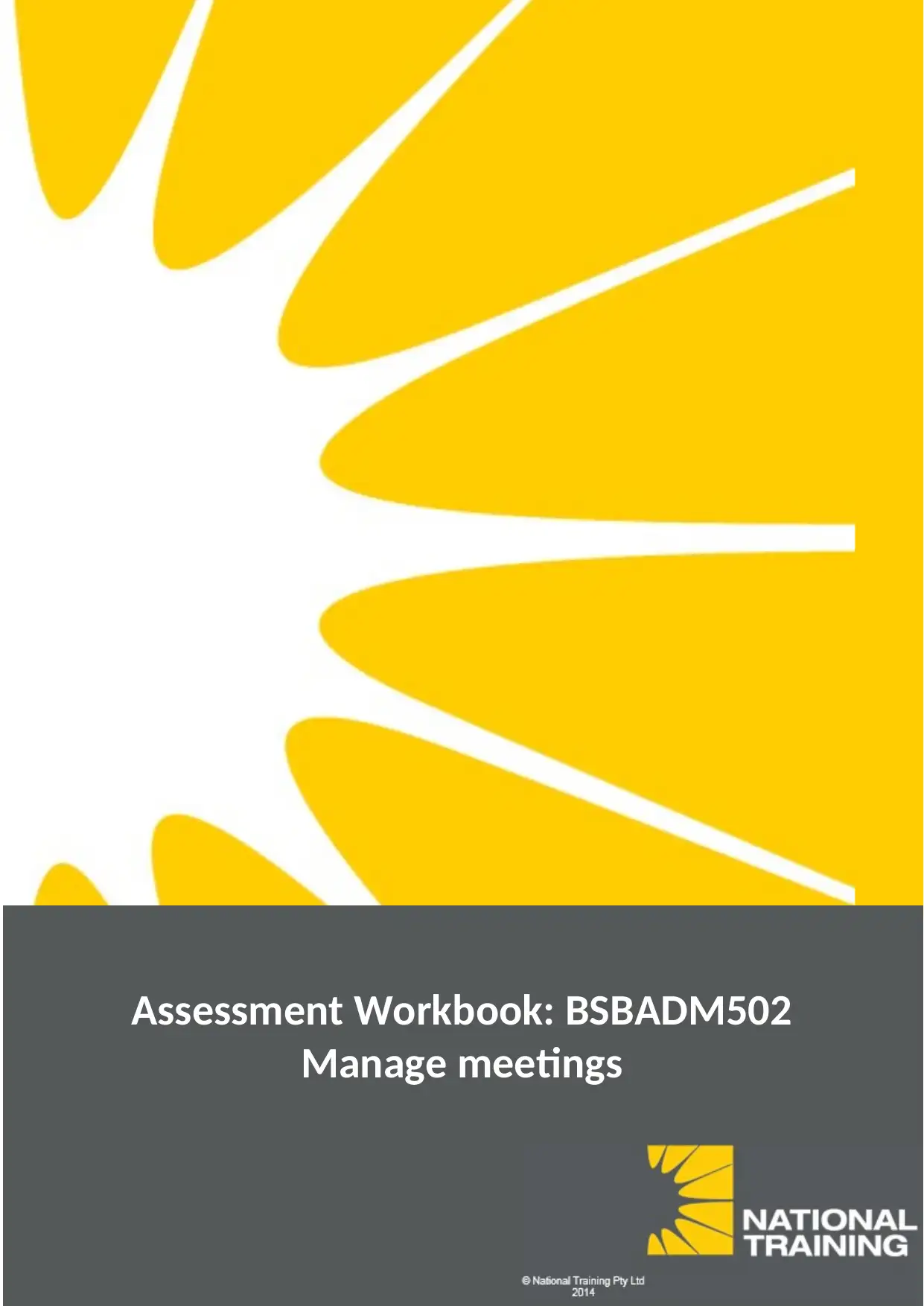
Assessment Workbook – BSBADM502 1 | P a g e Version 5.0
Assessment Workbook: BSBADM502
Manage meetings
Assessment Workbook: BSBADM502
Manage meetings
Paraphrase This Document
Need a fresh take? Get an instant paraphrase of this document with our AI Paraphraser
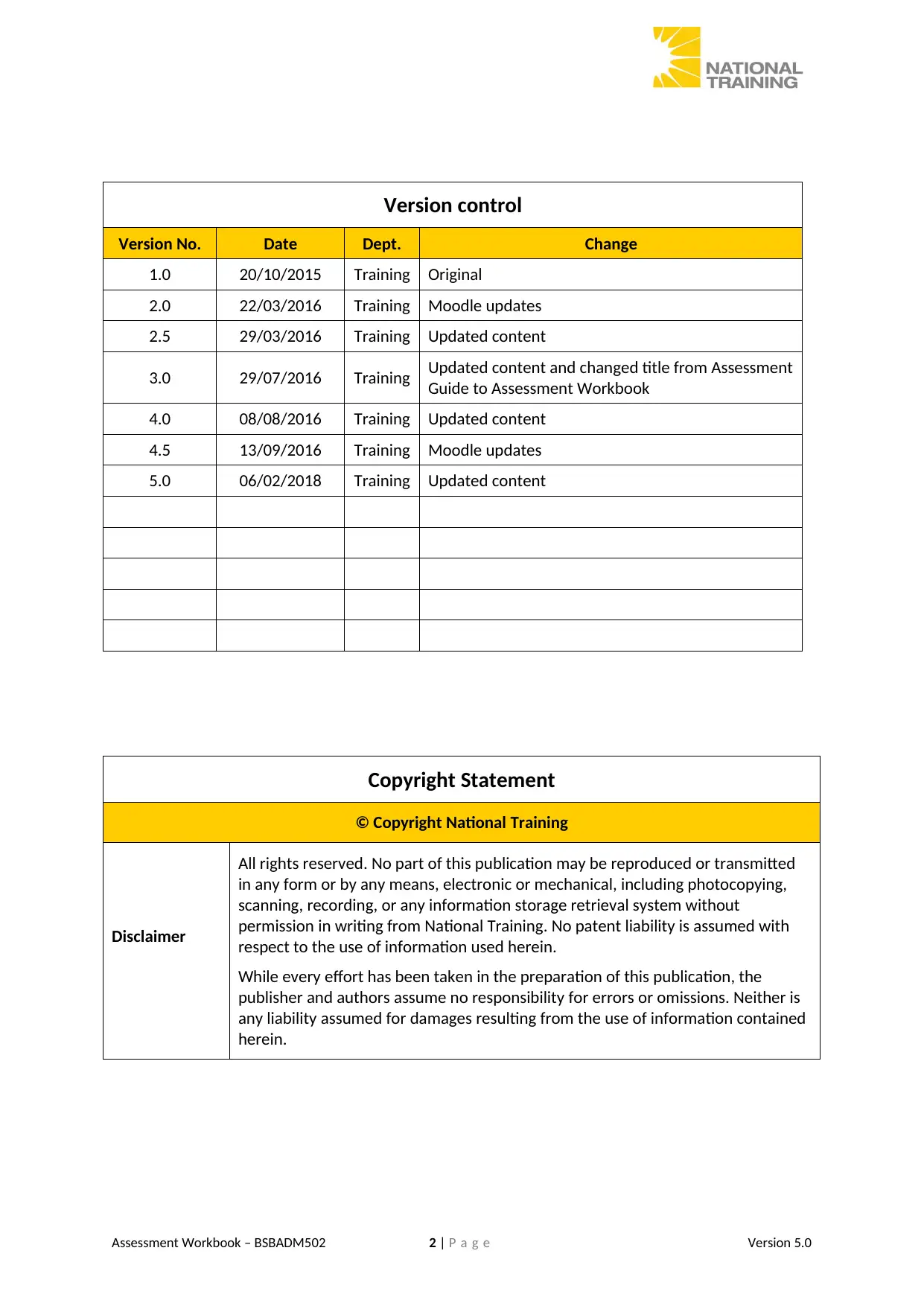
Version control
Version No. Date Dept. Change
1.0 20/10/2015 Training Original
2.0 22/03/2016 Training Moodle updates
2.5 29/03/2016 Training Updated content
3.0 29/07/2016 Training Updated content and changed title from Assessment
Guide to Assessment Workbook
4.0 08/08/2016 Training Updated content
4.5 13/09/2016 Training Moodle updates
5.0 06/02/2018 Training Updated content
Copyright Statement
© Copyright National Training
Disclaimer
All rights reserved. No part of this publication may be reproduced or transmitted
in any form or by any means, electronic or mechanical, including photocopying,
scanning, recording, or any information storage retrieval system without
permission in writing from National Training. No patent liability is assumed with
respect to the use of information used herein.
While every effort has been taken in the preparation of this publication, the
publisher and authors assume no responsibility for errors or omissions. Neither is
any liability assumed for damages resulting from the use of information contained
herein.
Assessment Workbook – BSBADM502 2 | P a g e Version 5.0
Version No. Date Dept. Change
1.0 20/10/2015 Training Original
2.0 22/03/2016 Training Moodle updates
2.5 29/03/2016 Training Updated content
3.0 29/07/2016 Training Updated content and changed title from Assessment
Guide to Assessment Workbook
4.0 08/08/2016 Training Updated content
4.5 13/09/2016 Training Moodle updates
5.0 06/02/2018 Training Updated content
Copyright Statement
© Copyright National Training
Disclaimer
All rights reserved. No part of this publication may be reproduced or transmitted
in any form or by any means, electronic or mechanical, including photocopying,
scanning, recording, or any information storage retrieval system without
permission in writing from National Training. No patent liability is assumed with
respect to the use of information used herein.
While every effort has been taken in the preparation of this publication, the
publisher and authors assume no responsibility for errors or omissions. Neither is
any liability assumed for damages resulting from the use of information contained
herein.
Assessment Workbook – BSBADM502 2 | P a g e Version 5.0
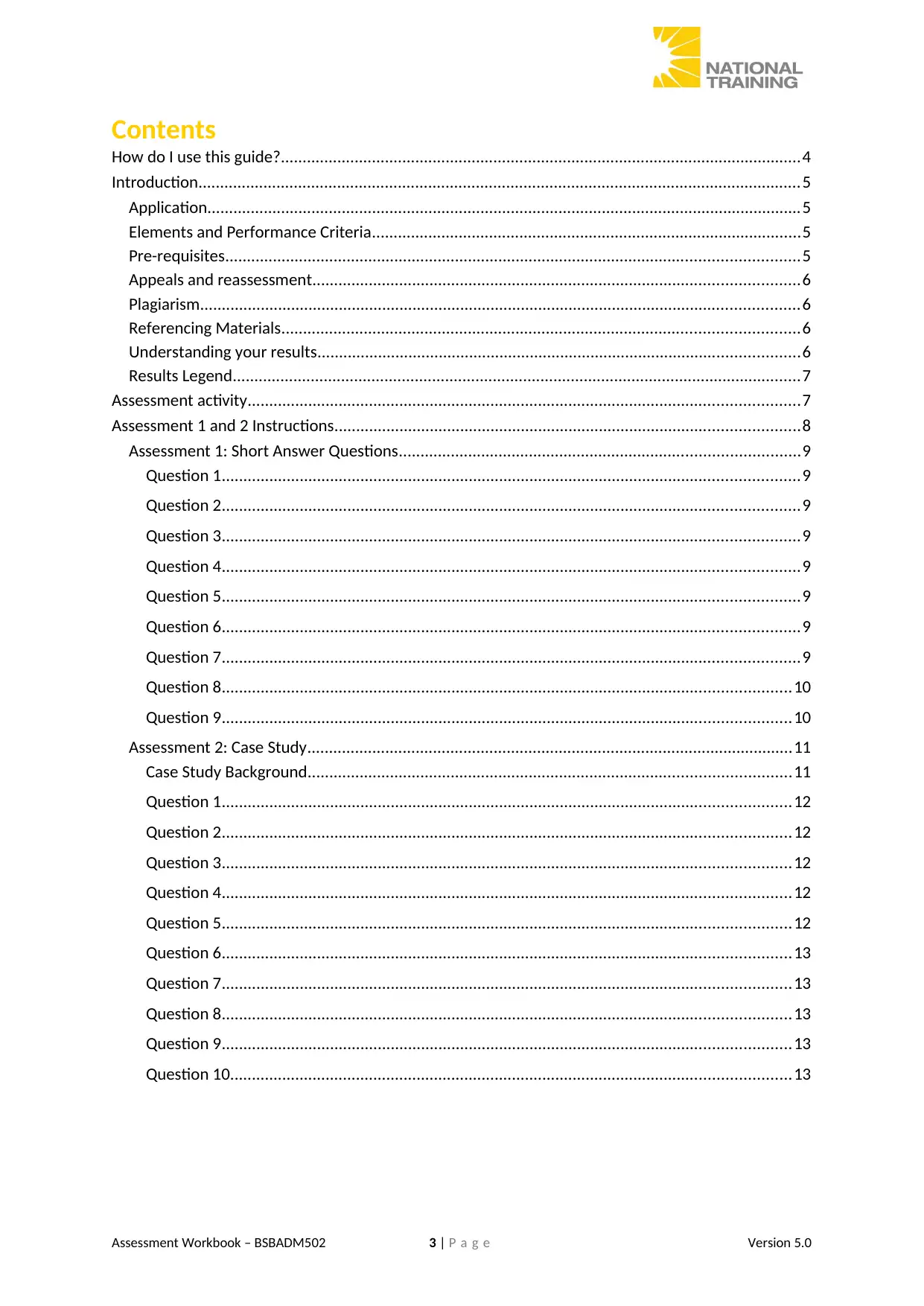
Contents
How do I use this guide?........................................................................................................................4
Introduction...........................................................................................................................................5
Application.........................................................................................................................................5
Elements and Performance Criteria...................................................................................................5
Pre-requisites....................................................................................................................................5
Appeals and reassessment................................................................................................................6
Plagiarism..........................................................................................................................................6
Referencing Materials.......................................................................................................................6
Understanding your results...............................................................................................................6
Results Legend...................................................................................................................................7
Assessment activity...............................................................................................................................7
Assessment 1 and 2 Instructions...........................................................................................................8
Assessment 1: Short Answer Questions............................................................................................9
Question 1.....................................................................................................................................9
Question 2.....................................................................................................................................9
Question 3.....................................................................................................................................9
Question 4.....................................................................................................................................9
Question 5.....................................................................................................................................9
Question 6.....................................................................................................................................9
Question 7.....................................................................................................................................9
Question 8...................................................................................................................................10
Question 9...................................................................................................................................10
Assessment 2: Case Study................................................................................................................11
Case Study Background...............................................................................................................11
Question 1...................................................................................................................................12
Question 2...................................................................................................................................12
Question 3...................................................................................................................................12
Question 4...................................................................................................................................12
Question 5...................................................................................................................................12
Question 6...................................................................................................................................13
Question 7...................................................................................................................................13
Question 8...................................................................................................................................13
Question 9...................................................................................................................................13
Question 10.................................................................................................................................13
Assessment Workbook – BSBADM502 3 | P a g e Version 5.0
How do I use this guide?........................................................................................................................4
Introduction...........................................................................................................................................5
Application.........................................................................................................................................5
Elements and Performance Criteria...................................................................................................5
Pre-requisites....................................................................................................................................5
Appeals and reassessment................................................................................................................6
Plagiarism..........................................................................................................................................6
Referencing Materials.......................................................................................................................6
Understanding your results...............................................................................................................6
Results Legend...................................................................................................................................7
Assessment activity...............................................................................................................................7
Assessment 1 and 2 Instructions...........................................................................................................8
Assessment 1: Short Answer Questions............................................................................................9
Question 1.....................................................................................................................................9
Question 2.....................................................................................................................................9
Question 3.....................................................................................................................................9
Question 4.....................................................................................................................................9
Question 5.....................................................................................................................................9
Question 6.....................................................................................................................................9
Question 7.....................................................................................................................................9
Question 8...................................................................................................................................10
Question 9...................................................................................................................................10
Assessment 2: Case Study................................................................................................................11
Case Study Background...............................................................................................................11
Question 1...................................................................................................................................12
Question 2...................................................................................................................................12
Question 3...................................................................................................................................12
Question 4...................................................................................................................................12
Question 5...................................................................................................................................12
Question 6...................................................................................................................................13
Question 7...................................................................................................................................13
Question 8...................................................................................................................................13
Question 9...................................................................................................................................13
Question 10.................................................................................................................................13
Assessment Workbook – BSBADM502 3 | P a g e Version 5.0
⊘ This is a preview!⊘
Do you want full access?
Subscribe today to unlock all pages.

Trusted by 1+ million students worldwide
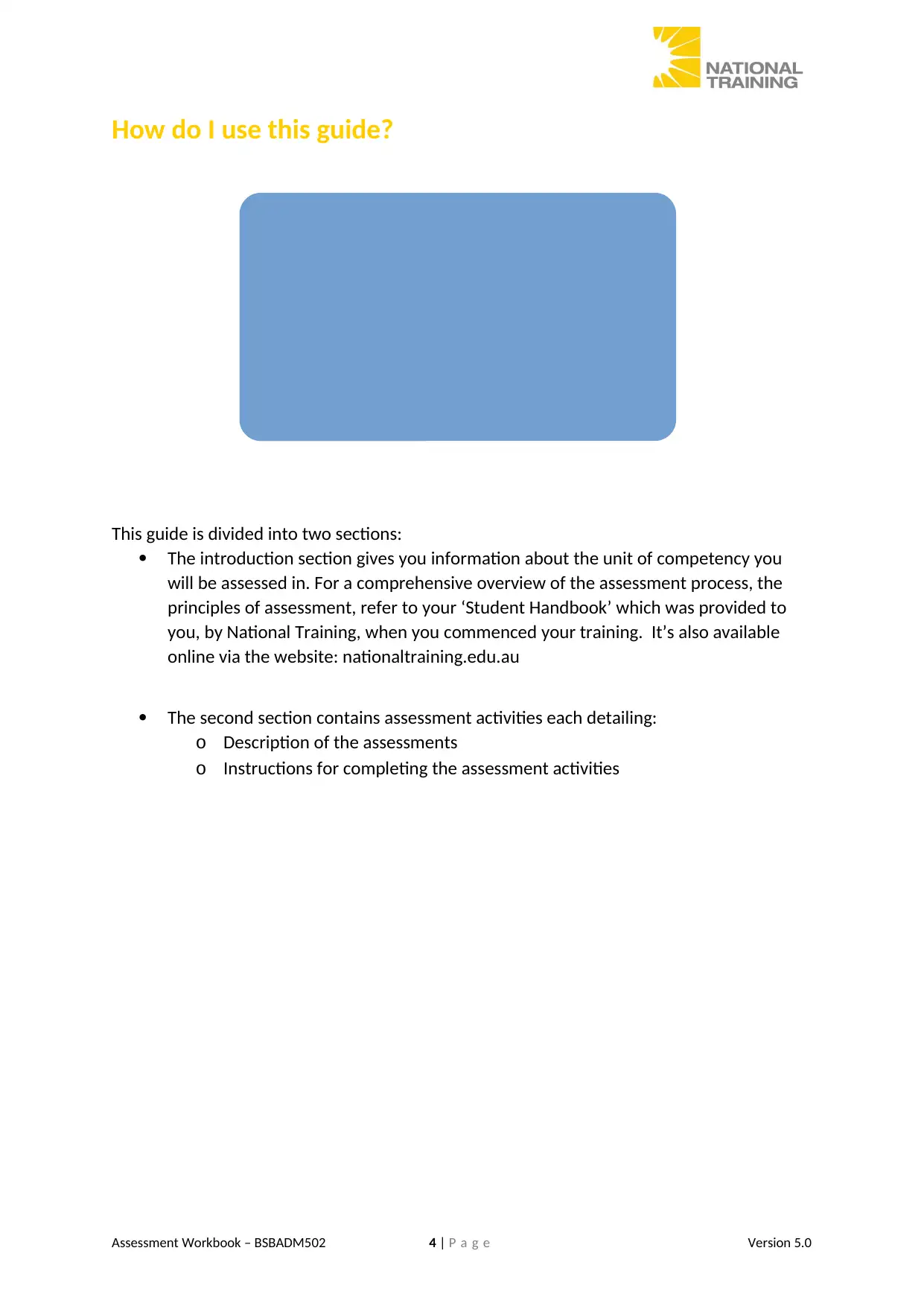
How do I use this guide?
This guide is divided into two sections:
The introduction section gives you information about the unit of competency you
will be assessed in. For a comprehensive overview of the assessment process, the
principles of assessment, refer to your ‘Student Handbook’ which was provided to
you, by National Training, when you commenced your training. It’s also available
online via the website: nationaltraining.edu.au
The second section contains assessment activities each detailing:
o Description of the assessments
o Instructions for completing the assessment activities
Assessment Workbook – BSBADM502 4 | P a g e Version 5.0
This guide is divided into two sections:
The introduction section gives you information about the unit of competency you
will be assessed in. For a comprehensive overview of the assessment process, the
principles of assessment, refer to your ‘Student Handbook’ which was provided to
you, by National Training, when you commenced your training. It’s also available
online via the website: nationaltraining.edu.au
The second section contains assessment activities each detailing:
o Description of the assessments
o Instructions for completing the assessment activities
Assessment Workbook – BSBADM502 4 | P a g e Version 5.0
Paraphrase This Document
Need a fresh take? Get an instant paraphrase of this document with our AI Paraphraser
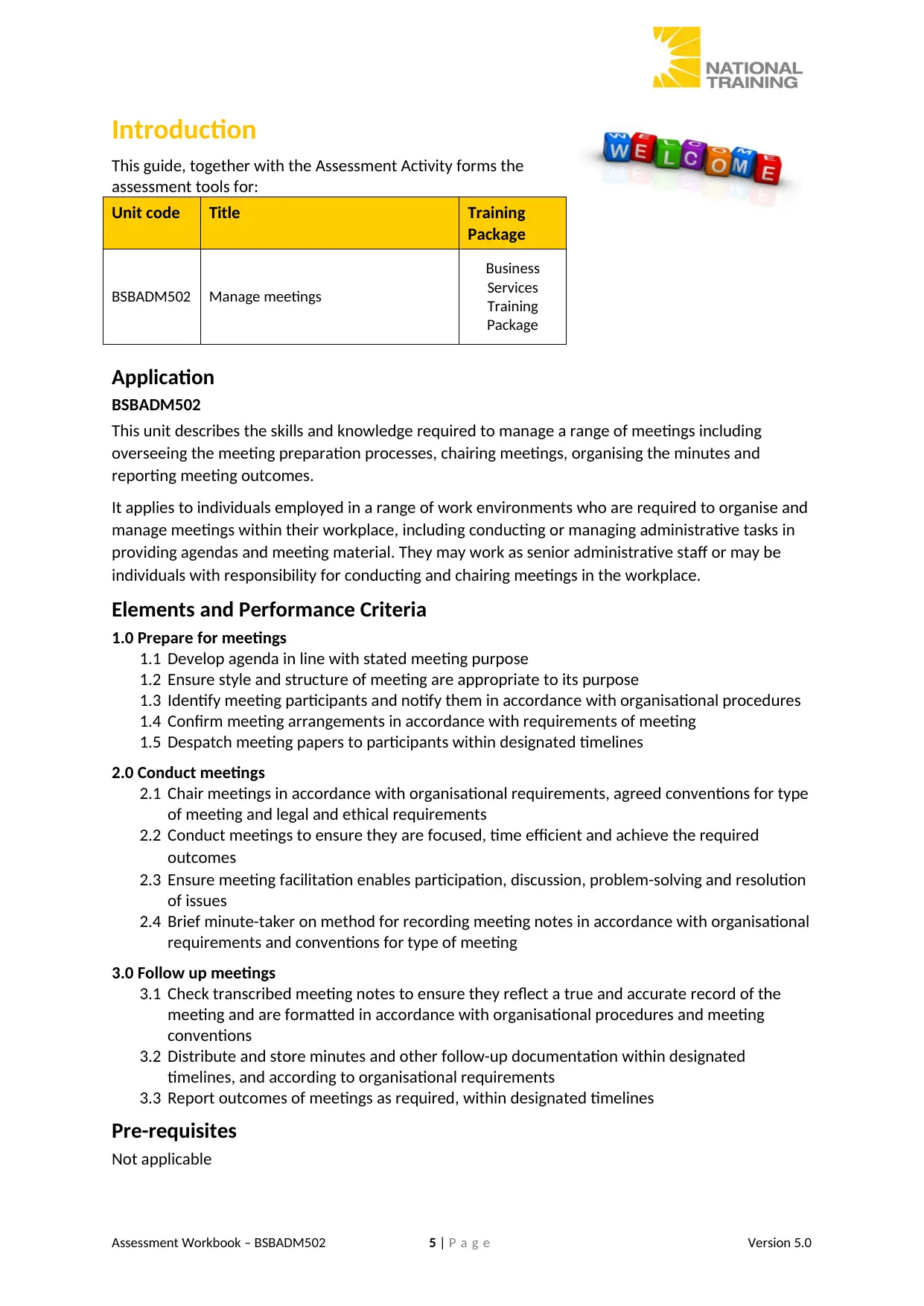
Introduction
This guide, together with the Assessment Activity forms the
assessment tools for:
Unit code Title Training
Package
BSBADM502 Manage meetings
Business
Services
Training
Package
Application
BSBADM502
This unit describes the skills and knowledge required to manage a range of meetings including
overseeing the meeting preparation processes, chairing meetings, organising the minutes and
reporting meeting outcomes.
It applies to individuals employed in a range of work environments who are required to organise and
manage meetings within their workplace, including conducting or managing administrative tasks in
providing agendas and meeting material. They may work as senior administrative staff or may be
individuals with responsibility for conducting and chairing meetings in the workplace.
Elements and Performance Criteria
1.0 Prepare for meetings
1.1 Develop agenda in line with stated meeting purpose
1.2 Ensure style and structure of meeting are appropriate to its purpose
1.3 Identify meeting participants and notify them in accordance with organisational procedures
1.4 Confirm meeting arrangements in accordance with requirements of meeting
1.5 Despatch meeting papers to participants within designated timelines
2.0 Conduct meetings
2.1 Chair meetings in accordance with organisational requirements, agreed conventions for type
of meeting and legal and ethical requirements
2.2 Conduct meetings to ensure they are focused, time efficient and achieve the required
outcomes
2.3 Ensure meeting facilitation enables participation, discussion, problem-solving and resolution
of issues
2.4 Brief minute-taker on method for recording meeting notes in accordance with organisational
requirements and conventions for type of meeting
3.0 Follow up meetings
3.1 Check transcribed meeting notes to ensure they reflect a true and accurate record of the
meeting and are formatted in accordance with organisational procedures and meeting
conventions
3.2 Distribute and store minutes and other follow-up documentation within designated
timelines, and according to organisational requirements
3.3 Report outcomes of meetings as required, within designated timelines
Pre-requisites
Not applicable
Assessment Workbook – BSBADM502 5 | P a g e Version 5.0
This guide, together with the Assessment Activity forms the
assessment tools for:
Unit code Title Training
Package
BSBADM502 Manage meetings
Business
Services
Training
Package
Application
BSBADM502
This unit describes the skills and knowledge required to manage a range of meetings including
overseeing the meeting preparation processes, chairing meetings, organising the minutes and
reporting meeting outcomes.
It applies to individuals employed in a range of work environments who are required to organise and
manage meetings within their workplace, including conducting or managing administrative tasks in
providing agendas and meeting material. They may work as senior administrative staff or may be
individuals with responsibility for conducting and chairing meetings in the workplace.
Elements and Performance Criteria
1.0 Prepare for meetings
1.1 Develop agenda in line with stated meeting purpose
1.2 Ensure style and structure of meeting are appropriate to its purpose
1.3 Identify meeting participants and notify them in accordance with organisational procedures
1.4 Confirm meeting arrangements in accordance with requirements of meeting
1.5 Despatch meeting papers to participants within designated timelines
2.0 Conduct meetings
2.1 Chair meetings in accordance with organisational requirements, agreed conventions for type
of meeting and legal and ethical requirements
2.2 Conduct meetings to ensure they are focused, time efficient and achieve the required
outcomes
2.3 Ensure meeting facilitation enables participation, discussion, problem-solving and resolution
of issues
2.4 Brief minute-taker on method for recording meeting notes in accordance with organisational
requirements and conventions for type of meeting
3.0 Follow up meetings
3.1 Check transcribed meeting notes to ensure they reflect a true and accurate record of the
meeting and are formatted in accordance with organisational procedures and meeting
conventions
3.2 Distribute and store minutes and other follow-up documentation within designated
timelines, and according to organisational requirements
3.3 Report outcomes of meetings as required, within designated timelines
Pre-requisites
Not applicable
Assessment Workbook – BSBADM502 5 | P a g e Version 5.0
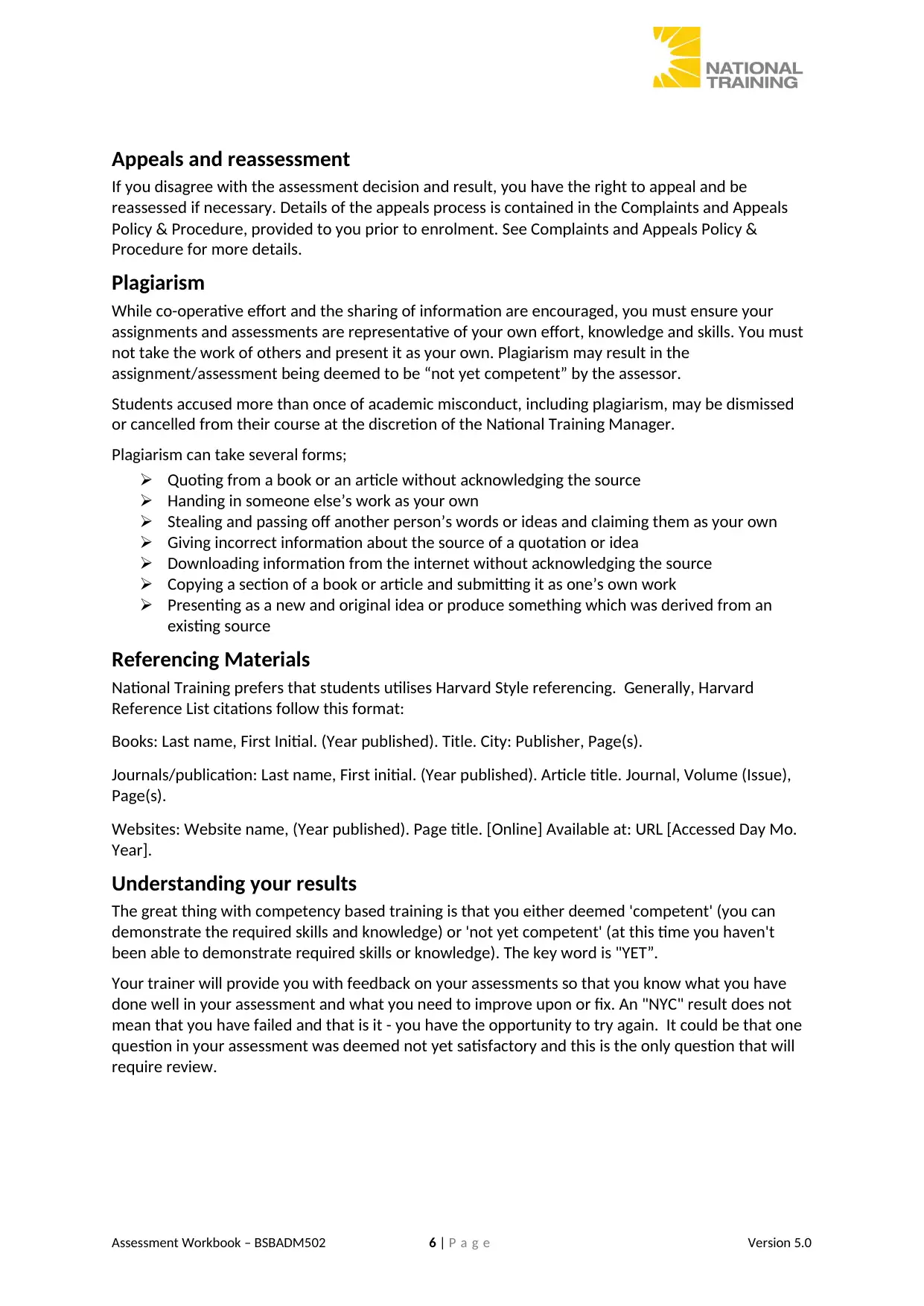
Appeals and reassessment
If you disagree with the assessment decision and result, you have the right to appeal and be
reassessed if necessary. Details of the appeals process is contained in the Complaints and Appeals
Policy & Procedure, provided to you prior to enrolment. See Complaints and Appeals Policy &
Procedure for more details.
Plagiarism
While co-operative effort and the sharing of information are encouraged, you must ensure your
assignments and assessments are representative of your own effort, knowledge and skills. You must
not take the work of others and present it as your own. Plagiarism may result in the
assignment/assessment being deemed to be “not yet competent” by the assessor.
Students accused more than once of academic misconduct, including plagiarism, may be dismissed
or cancelled from their course at the discretion of the National Training Manager.
Plagiarism can take several forms;
Quoting from a book or an article without acknowledging the source
Handing in someone else’s work as your own
Stealing and passing off another person’s words or ideas and claiming them as your own
Giving incorrect information about the source of a quotation or idea
Downloading information from the internet without acknowledging the source
Copying a section of a book or article and submitting it as one’s own work
Presenting as a new and original idea or produce something which was derived from an
existing source
Referencing Materials
National Training prefers that students utilises Harvard Style referencing. Generally, Harvard
Reference List citations follow this format:
Books: Last name, First Initial. (Year published). Title. City: Publisher, Page(s).
Journals/publication: Last name, First initial. (Year published). Article title. Journal, Volume (Issue),
Page(s).
Websites: Website name, (Year published). Page title. [Online] Available at: URL [Accessed Day Mo.
Year].
Understanding your results
The great thing with competency based training is that you either deemed 'competent' (you can
demonstrate the required skills and knowledge) or 'not yet competent' (at this time you haven't
been able to demonstrate required skills or knowledge). The key word is "YET”.
Your trainer will provide you with feedback on your assessments so that you know what you have
done well in your assessment and what you need to improve upon or fix. An "NYC" result does not
mean that you have failed and that is it - you have the opportunity to try again. It could be that one
question in your assessment was deemed not yet satisfactory and this is the only question that will
require review.
Assessment Workbook – BSBADM502 6 | P a g e Version 5.0
If you disagree with the assessment decision and result, you have the right to appeal and be
reassessed if necessary. Details of the appeals process is contained in the Complaints and Appeals
Policy & Procedure, provided to you prior to enrolment. See Complaints and Appeals Policy &
Procedure for more details.
Plagiarism
While co-operative effort and the sharing of information are encouraged, you must ensure your
assignments and assessments are representative of your own effort, knowledge and skills. You must
not take the work of others and present it as your own. Plagiarism may result in the
assignment/assessment being deemed to be “not yet competent” by the assessor.
Students accused more than once of academic misconduct, including plagiarism, may be dismissed
or cancelled from their course at the discretion of the National Training Manager.
Plagiarism can take several forms;
Quoting from a book or an article without acknowledging the source
Handing in someone else’s work as your own
Stealing and passing off another person’s words or ideas and claiming them as your own
Giving incorrect information about the source of a quotation or idea
Downloading information from the internet without acknowledging the source
Copying a section of a book or article and submitting it as one’s own work
Presenting as a new and original idea or produce something which was derived from an
existing source
Referencing Materials
National Training prefers that students utilises Harvard Style referencing. Generally, Harvard
Reference List citations follow this format:
Books: Last name, First Initial. (Year published). Title. City: Publisher, Page(s).
Journals/publication: Last name, First initial. (Year published). Article title. Journal, Volume (Issue),
Page(s).
Websites: Website name, (Year published). Page title. [Online] Available at: URL [Accessed Day Mo.
Year].
Understanding your results
The great thing with competency based training is that you either deemed 'competent' (you can
demonstrate the required skills and knowledge) or 'not yet competent' (at this time you haven't
been able to demonstrate required skills or knowledge). The key word is "YET”.
Your trainer will provide you with feedback on your assessments so that you know what you have
done well in your assessment and what you need to improve upon or fix. An "NYC" result does not
mean that you have failed and that is it - you have the opportunity to try again. It could be that one
question in your assessment was deemed not yet satisfactory and this is the only question that will
require review.
Assessment Workbook – BSBADM502 6 | P a g e Version 5.0
⊘ This is a preview!⊘
Do you want full access?
Subscribe today to unlock all pages.

Trusted by 1+ million students worldwide
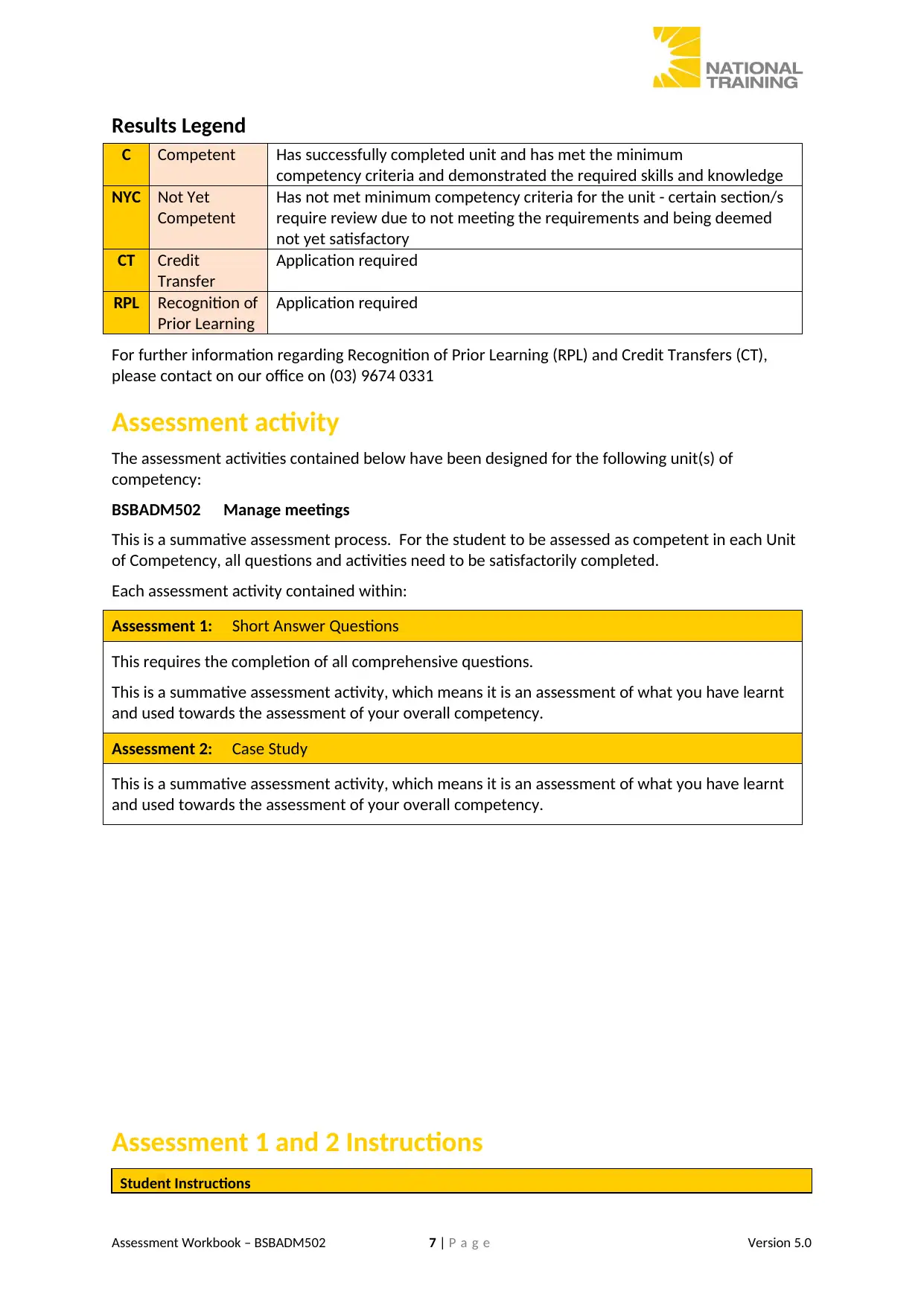
Results Legend
C Competent Has successfully completed unit and has met the minimum
competency criteria and demonstrated the required skills and knowledge
NYC Not Yet
Competent
Has not met minimum competency criteria for the unit - certain section/s
require review due to not meeting the requirements and being deemed
not yet satisfactory
CT Credit
Transfer
Application required
RPL Recognition of
Prior Learning
Application required
For further information regarding Recognition of Prior Learning (RPL) and Credit Transfers (CT),
please contact on our office on (03) 9674 0331
Assessment activity
The assessment activities contained below have been designed for the following unit(s) of
competency:
BSBADM502 Manage meetings
This is a summative assessment process. For the student to be assessed as competent in each Unit
of Competency, all questions and activities need to be satisfactorily completed.
Each assessment activity contained within:
Assessment 1: Short Answer Questions
This requires the completion of all comprehensive questions.
This is a summative assessment activity, which means it is an assessment of what you have learnt
and used towards the assessment of your overall competency.
Assessment 2: Case Study
This is a summative assessment activity, which means it is an assessment of what you have learnt
and used towards the assessment of your overall competency.
Assessment 1 and 2 Instructions
Student Instructions
Assessment Workbook – BSBADM502 7 | P a g e Version 5.0
C Competent Has successfully completed unit and has met the minimum
competency criteria and demonstrated the required skills and knowledge
NYC Not Yet
Competent
Has not met minimum competency criteria for the unit - certain section/s
require review due to not meeting the requirements and being deemed
not yet satisfactory
CT Credit
Transfer
Application required
RPL Recognition of
Prior Learning
Application required
For further information regarding Recognition of Prior Learning (RPL) and Credit Transfers (CT),
please contact on our office on (03) 9674 0331
Assessment activity
The assessment activities contained below have been designed for the following unit(s) of
competency:
BSBADM502 Manage meetings
This is a summative assessment process. For the student to be assessed as competent in each Unit
of Competency, all questions and activities need to be satisfactorily completed.
Each assessment activity contained within:
Assessment 1: Short Answer Questions
This requires the completion of all comprehensive questions.
This is a summative assessment activity, which means it is an assessment of what you have learnt
and used towards the assessment of your overall competency.
Assessment 2: Case Study
This is a summative assessment activity, which means it is an assessment of what you have learnt
and used towards the assessment of your overall competency.
Assessment 1 and 2 Instructions
Student Instructions
Assessment Workbook – BSBADM502 7 | P a g e Version 5.0
Paraphrase This Document
Need a fresh take? Get an instant paraphrase of this document with our AI Paraphraser
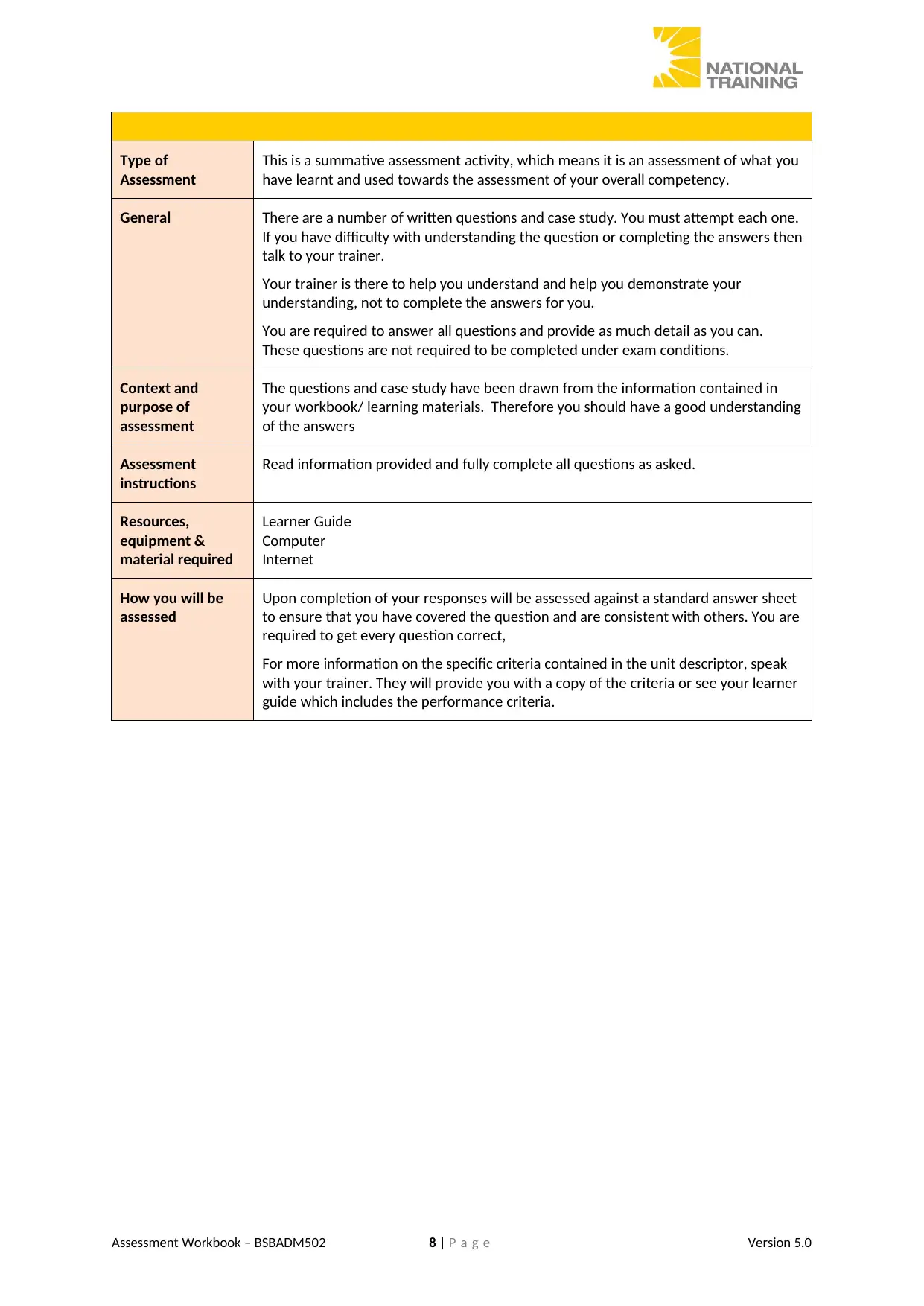
Type of
Assessment
This is a summative assessment activity, which means it is an assessment of what you
have learnt and used towards the assessment of your overall competency.
General There are a number of written questions and case study. You must attempt each one.
If you have difficulty with understanding the question or completing the answers then
talk to your trainer.
Your trainer is there to help you understand and help you demonstrate your
understanding, not to complete the answers for you.
You are required to answer all questions and provide as much detail as you can.
These questions are not required to be completed under exam conditions.
Context and
purpose of
assessment
The questions and case study have been drawn from the information contained in
your workbook/ learning materials. Therefore you should have a good understanding
of the answers
Assessment
instructions
Read information provided and fully complete all questions as asked.
Resources,
equipment &
material required
Learner Guide
Computer
Internet
How you will be
assessed
Upon completion of your responses will be assessed against a standard answer sheet
to ensure that you have covered the question and are consistent with others. You are
required to get every question correct,
For more information on the specific criteria contained in the unit descriptor, speak
with your trainer. They will provide you with a copy of the criteria or see your learner
guide which includes the performance criteria.
Assessment Workbook – BSBADM502 8 | P a g e Version 5.0
Assessment
This is a summative assessment activity, which means it is an assessment of what you
have learnt and used towards the assessment of your overall competency.
General There are a number of written questions and case study. You must attempt each one.
If you have difficulty with understanding the question or completing the answers then
talk to your trainer.
Your trainer is there to help you understand and help you demonstrate your
understanding, not to complete the answers for you.
You are required to answer all questions and provide as much detail as you can.
These questions are not required to be completed under exam conditions.
Context and
purpose of
assessment
The questions and case study have been drawn from the information contained in
your workbook/ learning materials. Therefore you should have a good understanding
of the answers
Assessment
instructions
Read information provided and fully complete all questions as asked.
Resources,
equipment &
material required
Learner Guide
Computer
Internet
How you will be
assessed
Upon completion of your responses will be assessed against a standard answer sheet
to ensure that you have covered the question and are consistent with others. You are
required to get every question correct,
For more information on the specific criteria contained in the unit descriptor, speak
with your trainer. They will provide you with a copy of the criteria or see your learner
guide which includes the performance criteria.
Assessment Workbook – BSBADM502 8 | P a g e Version 5.0
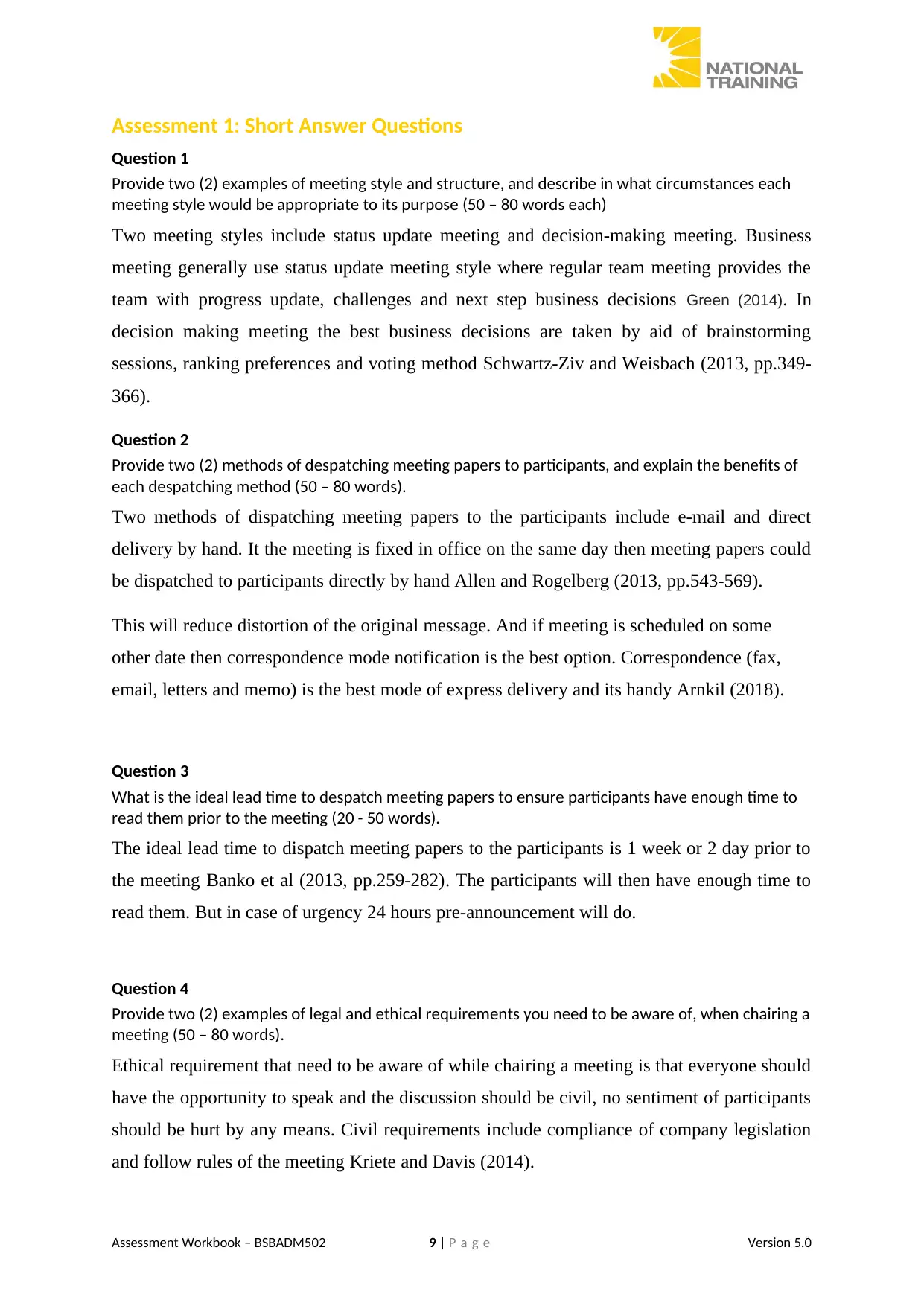
Assessment 1: Short Answer Questions
Question 1
Provide two (2) examples of meeting style and structure, and describe in what circumstances each
meeting style would be appropriate to its purpose (50 – 80 words each)
Two meeting styles include status update meeting and decision-making meeting. Business
meeting generally use status update meeting style where regular team meeting provides the
team with progress update, challenges and next step business decisions Green (2014). In
decision making meeting the best business decisions are taken by aid of brainstorming
sessions, ranking preferences and voting method Schwartz-Ziv and Weisbach (2013, pp.349-
366).
Question 2
Provide two (2) methods of despatching meeting papers to participants, and explain the benefits of
each despatching method (50 – 80 words).
Two methods of dispatching meeting papers to the participants include e-mail and direct
delivery by hand. It the meeting is fixed in office on the same day then meeting papers could
be dispatched to participants directly by hand Allen and Rogelberg (2013, pp.543-569).
This will reduce distortion of the original message. And if meeting is scheduled on some
other date then correspondence mode notification is the best option. Correspondence (fax,
email, letters and memo) is the best mode of express delivery and its handy Arnkil (2018).
Question 3
What is the ideal lead time to despatch meeting papers to ensure participants have enough time to
read them prior to the meeting (20 - 50 words).
The ideal lead time to dispatch meeting papers to the participants is 1 week or 2 day prior to
the meeting Banko et al (2013, pp.259-282). The participants will then have enough time to
read them. But in case of urgency 24 hours pre-announcement will do.
Question 4
Provide two (2) examples of legal and ethical requirements you need to be aware of, when chairing a
meeting (50 – 80 words).
Ethical requirement that need to be aware of while chairing a meeting is that everyone should
have the opportunity to speak and the discussion should be civil, no sentiment of participants
should be hurt by any means. Civil requirements include compliance of company legislation
and follow rules of the meeting Kriete and Davis (2014).
Assessment Workbook – BSBADM502 9 | P a g e Version 5.0
Question 1
Provide two (2) examples of meeting style and structure, and describe in what circumstances each
meeting style would be appropriate to its purpose (50 – 80 words each)
Two meeting styles include status update meeting and decision-making meeting. Business
meeting generally use status update meeting style where regular team meeting provides the
team with progress update, challenges and next step business decisions Green (2014). In
decision making meeting the best business decisions are taken by aid of brainstorming
sessions, ranking preferences and voting method Schwartz-Ziv and Weisbach (2013, pp.349-
366).
Question 2
Provide two (2) methods of despatching meeting papers to participants, and explain the benefits of
each despatching method (50 – 80 words).
Two methods of dispatching meeting papers to the participants include e-mail and direct
delivery by hand. It the meeting is fixed in office on the same day then meeting papers could
be dispatched to participants directly by hand Allen and Rogelberg (2013, pp.543-569).
This will reduce distortion of the original message. And if meeting is scheduled on some
other date then correspondence mode notification is the best option. Correspondence (fax,
email, letters and memo) is the best mode of express delivery and its handy Arnkil (2018).
Question 3
What is the ideal lead time to despatch meeting papers to ensure participants have enough time to
read them prior to the meeting (20 - 50 words).
The ideal lead time to dispatch meeting papers to the participants is 1 week or 2 day prior to
the meeting Banko et al (2013, pp.259-282). The participants will then have enough time to
read them. But in case of urgency 24 hours pre-announcement will do.
Question 4
Provide two (2) examples of legal and ethical requirements you need to be aware of, when chairing a
meeting (50 – 80 words).
Ethical requirement that need to be aware of while chairing a meeting is that everyone should
have the opportunity to speak and the discussion should be civil, no sentiment of participants
should be hurt by any means. Civil requirements include compliance of company legislation
and follow rules of the meeting Kriete and Davis (2014).
Assessment Workbook – BSBADM502 9 | P a g e Version 5.0
⊘ This is a preview!⊘
Do you want full access?
Subscribe today to unlock all pages.

Trusted by 1+ million students worldwide
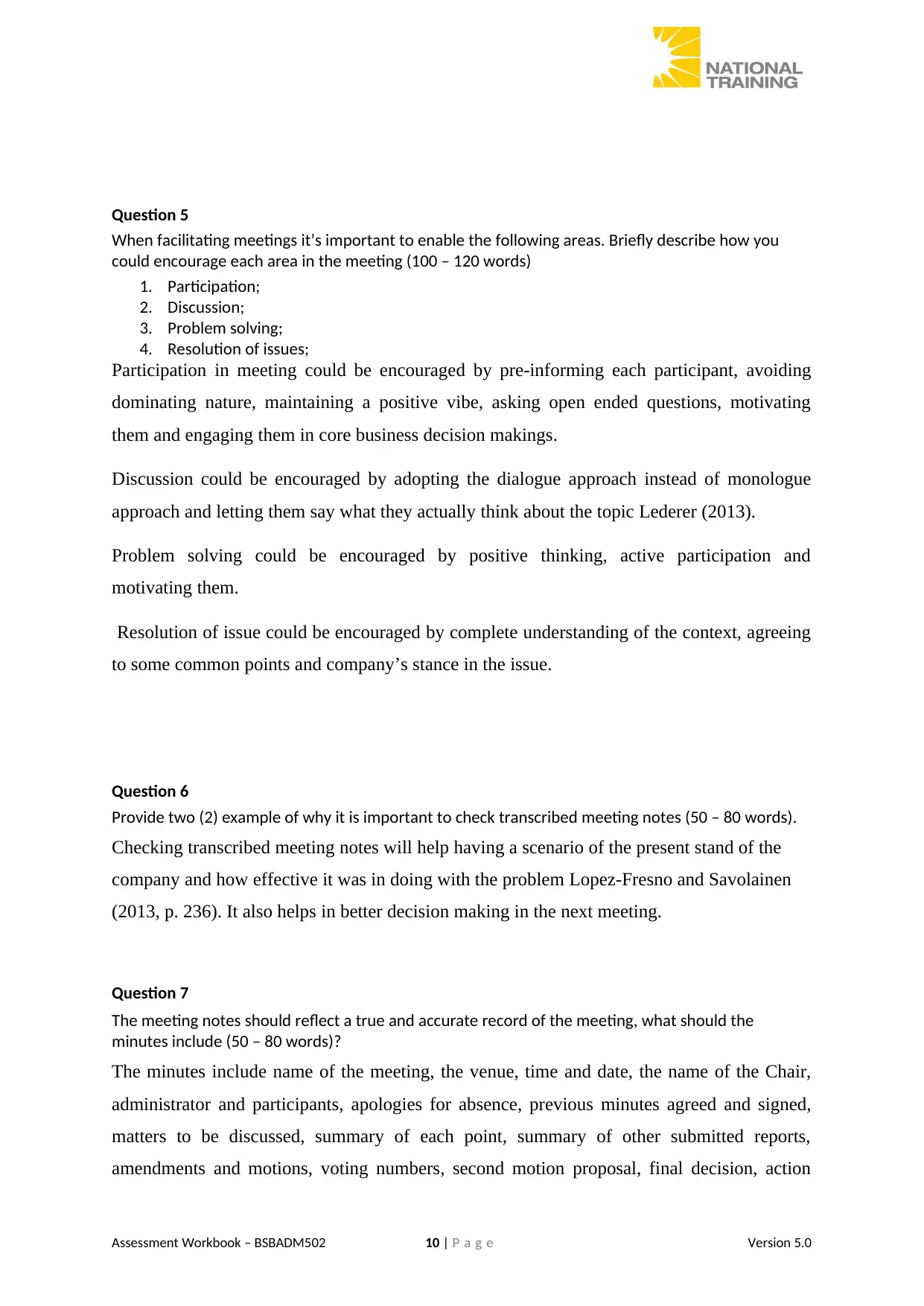
Question 5
When facilitating meetings it’s important to enable the following areas. Briefly describe how you
could encourage each area in the meeting (100 – 120 words)
1. Participation;
2. Discussion;
3. Problem solving;
4. Resolution of issues;
Participation in meeting could be encouraged by pre-informing each participant, avoiding
dominating nature, maintaining a positive vibe, asking open ended questions, motivating
them and engaging them in core business decision makings.
Discussion could be encouraged by adopting the dialogue approach instead of monologue
approach and letting them say what they actually think about the topic Lederer (2013).
Problem solving could be encouraged by positive thinking, active participation and
motivating them.
Resolution of issue could be encouraged by complete understanding of the context, agreeing
to some common points and company’s stance in the issue.
Question 6
Provide two (2) example of why it is important to check transcribed meeting notes (50 – 80 words).
Checking transcribed meeting notes will help having a scenario of the present stand of the
company and how effective it was in doing with the problem Lopez-Fresno and Savolainen
(2013, p. 236). It also helps in better decision making in the next meeting.
Question 7
The meeting notes should reflect a true and accurate record of the meeting, what should the
minutes include (50 – 80 words)?
The minutes include name of the meeting, the venue, time and date, the name of the Chair,
administrator and participants, apologies for absence, previous minutes agreed and signed,
matters to be discussed, summary of each point, summary of other submitted reports,
amendments and motions, voting numbers, second motion proposal, final decision, action
Assessment Workbook – BSBADM502 10 | P a g e Version 5.0
When facilitating meetings it’s important to enable the following areas. Briefly describe how you
could encourage each area in the meeting (100 – 120 words)
1. Participation;
2. Discussion;
3. Problem solving;
4. Resolution of issues;
Participation in meeting could be encouraged by pre-informing each participant, avoiding
dominating nature, maintaining a positive vibe, asking open ended questions, motivating
them and engaging them in core business decision makings.
Discussion could be encouraged by adopting the dialogue approach instead of monologue
approach and letting them say what they actually think about the topic Lederer (2013).
Problem solving could be encouraged by positive thinking, active participation and
motivating them.
Resolution of issue could be encouraged by complete understanding of the context, agreeing
to some common points and company’s stance in the issue.
Question 6
Provide two (2) example of why it is important to check transcribed meeting notes (50 – 80 words).
Checking transcribed meeting notes will help having a scenario of the present stand of the
company and how effective it was in doing with the problem Lopez-Fresno and Savolainen
(2013, p. 236). It also helps in better decision making in the next meeting.
Question 7
The meeting notes should reflect a true and accurate record of the meeting, what should the
minutes include (50 – 80 words)?
The minutes include name of the meeting, the venue, time and date, the name of the Chair,
administrator and participants, apologies for absence, previous minutes agreed and signed,
matters to be discussed, summary of each point, summary of other submitted reports,
amendments and motions, voting numbers, second motion proposal, final decision, action
Assessment Workbook – BSBADM502 10 | P a g e Version 5.0
Paraphrase This Document
Need a fresh take? Get an instant paraphrase of this document with our AI Paraphraser
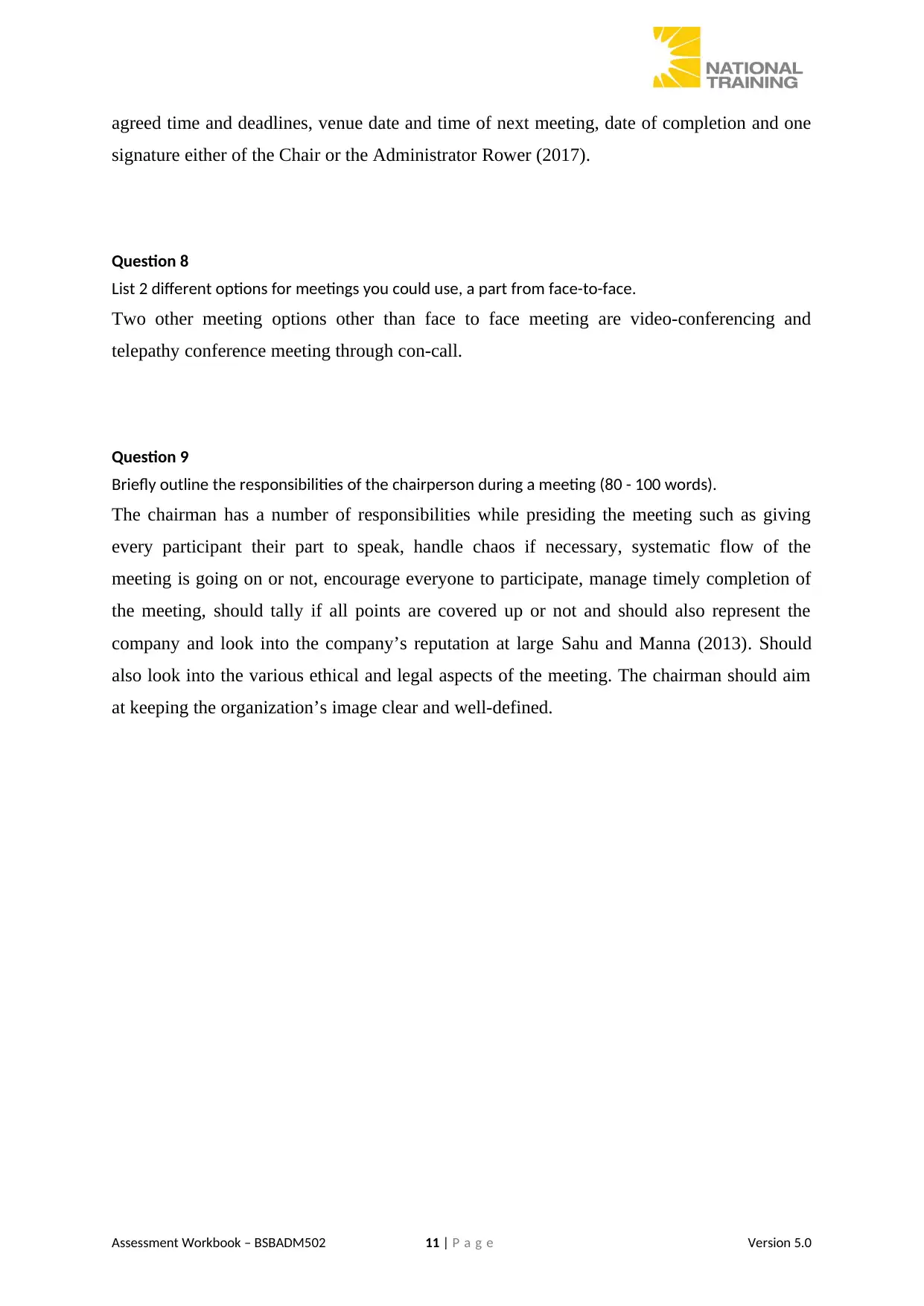
agreed time and deadlines, venue date and time of next meeting, date of completion and one
signature either of the Chair or the Administrator Rower (2017).
Question 8
List 2 different options for meetings you could use, a part from face-to-face.
Two other meeting options other than face to face meeting are video-conferencing and
telepathy conference meeting through con-call.
Question 9
Briefly outline the responsibilities of the chairperson during a meeting (80 - 100 words).
The chairman has a number of responsibilities while presiding the meeting such as giving
every participant their part to speak, handle chaos if necessary, systematic flow of the
meeting is going on or not, encourage everyone to participate, manage timely completion of
the meeting, should tally if all points are covered up or not and should also represent the
company and look into the company’s reputation at large Sahu and Manna (2013). Should
also look into the various ethical and legal aspects of the meeting. The chairman should aim
at keeping the organization’s image clear and well-defined.
Assessment Workbook – BSBADM502 11 | P a g e Version 5.0
signature either of the Chair or the Administrator Rower (2017).
Question 8
List 2 different options for meetings you could use, a part from face-to-face.
Two other meeting options other than face to face meeting are video-conferencing and
telepathy conference meeting through con-call.
Question 9
Briefly outline the responsibilities of the chairperson during a meeting (80 - 100 words).
The chairman has a number of responsibilities while presiding the meeting such as giving
every participant their part to speak, handle chaos if necessary, systematic flow of the
meeting is going on or not, encourage everyone to participate, manage timely completion of
the meeting, should tally if all points are covered up or not and should also represent the
company and look into the company’s reputation at large Sahu and Manna (2013). Should
also look into the various ethical and legal aspects of the meeting. The chairman should aim
at keeping the organization’s image clear and well-defined.
Assessment Workbook – BSBADM502 11 | P a g e Version 5.0
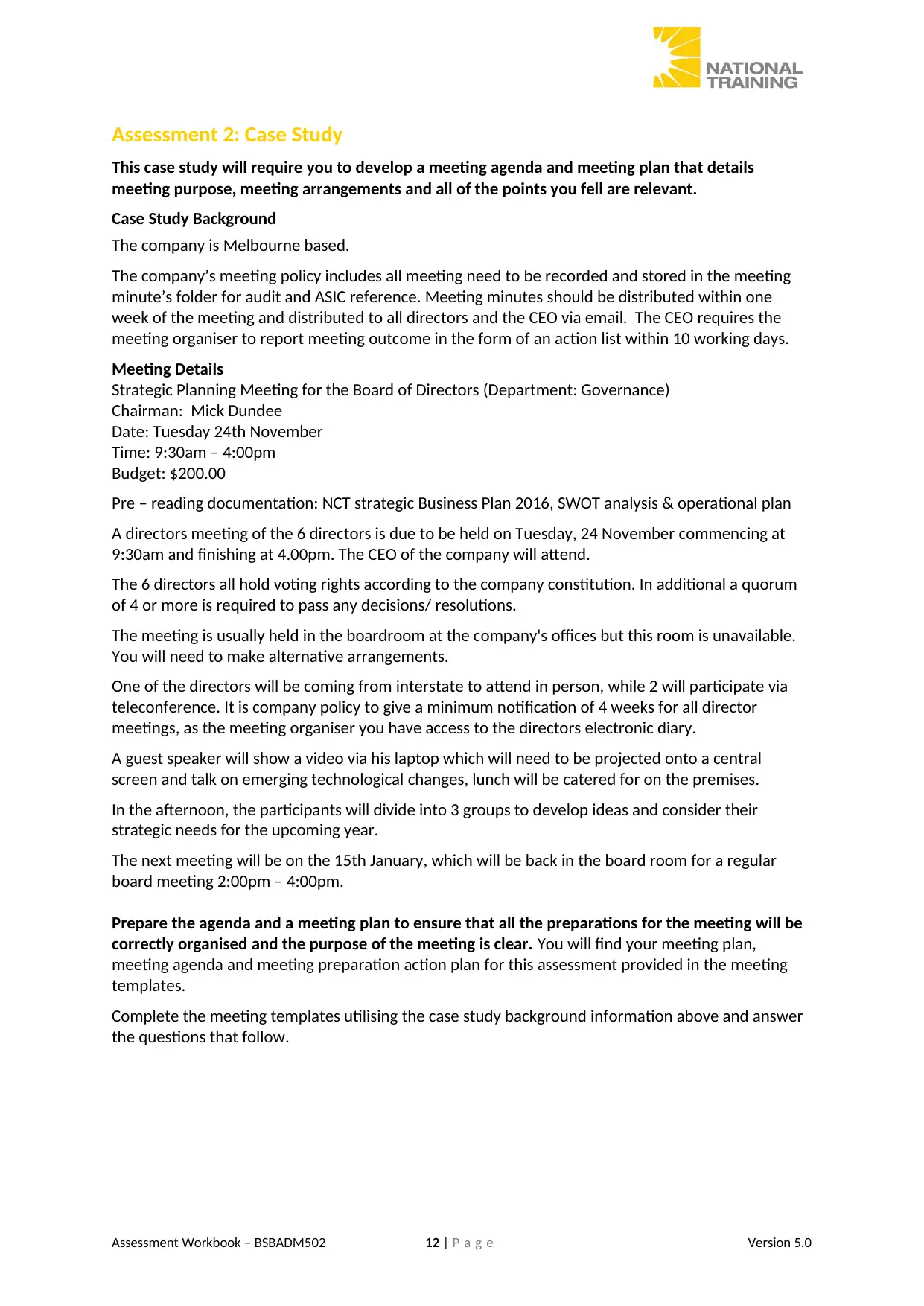
Assessment 2: Case Study
This case study will require you to develop a meeting agenda and meeting plan that details
meeting purpose, meeting arrangements and all of the points you fell are relevant.
Case Study Background
The company is Melbourne based.
The company’s meeting policy includes all meeting need to be recorded and stored in the meeting
minute’s folder for audit and ASIC reference. Meeting minutes should be distributed within one
week of the meeting and distributed to all directors and the CEO via email. The CEO requires the
meeting organiser to report meeting outcome in the form of an action list within 10 working days.
Meeting Details
Strategic Planning Meeting for the Board of Directors (Department: Governance)
Chairman: Mick Dundee
Date: Tuesday 24th November
Time: 9:30am – 4:00pm
Budget: $200.00
Pre – reading documentation: NCT strategic Business Plan 2016, SWOT analysis & operational plan
A directors meeting of the 6 directors is due to be held on Tuesday, 24 November commencing at
9:30am and finishing at 4.00pm. The CEO of the company will attend.
The 6 directors all hold voting rights according to the company constitution. In additional a quorum
of 4 or more is required to pass any decisions/ resolutions.
The meeting is usually held in the boardroom at the company's offices but this room is unavailable.
You will need to make alternative arrangements.
One of the directors will be coming from interstate to attend in person, while 2 will participate via
teleconference. It is company policy to give a minimum notification of 4 weeks for all director
meetings, as the meeting organiser you have access to the directors electronic diary.
A guest speaker will show a video via his laptop which will need to be projected onto a central
screen and talk on emerging technological changes, lunch will be catered for on the premises.
In the afternoon, the participants will divide into 3 groups to develop ideas and consider their
strategic needs for the upcoming year.
The next meeting will be on the 15th January, which will be back in the board room for a regular
board meeting 2:00pm – 4:00pm.
Prepare the agenda and a meeting plan to ensure that all the preparations for the meeting will be
correctly organised and the purpose of the meeting is clear. You will find your meeting plan,
meeting agenda and meeting preparation action plan for this assessment provided in the meeting
templates.
Complete the meeting templates utilising the case study background information above and answer
the questions that follow.
Assessment Workbook – BSBADM502 12 | P a g e Version 5.0
This case study will require you to develop a meeting agenda and meeting plan that details
meeting purpose, meeting arrangements and all of the points you fell are relevant.
Case Study Background
The company is Melbourne based.
The company’s meeting policy includes all meeting need to be recorded and stored in the meeting
minute’s folder for audit and ASIC reference. Meeting minutes should be distributed within one
week of the meeting and distributed to all directors and the CEO via email. The CEO requires the
meeting organiser to report meeting outcome in the form of an action list within 10 working days.
Meeting Details
Strategic Planning Meeting for the Board of Directors (Department: Governance)
Chairman: Mick Dundee
Date: Tuesday 24th November
Time: 9:30am – 4:00pm
Budget: $200.00
Pre – reading documentation: NCT strategic Business Plan 2016, SWOT analysis & operational plan
A directors meeting of the 6 directors is due to be held on Tuesday, 24 November commencing at
9:30am and finishing at 4.00pm. The CEO of the company will attend.
The 6 directors all hold voting rights according to the company constitution. In additional a quorum
of 4 or more is required to pass any decisions/ resolutions.
The meeting is usually held in the boardroom at the company's offices but this room is unavailable.
You will need to make alternative arrangements.
One of the directors will be coming from interstate to attend in person, while 2 will participate via
teleconference. It is company policy to give a minimum notification of 4 weeks for all director
meetings, as the meeting organiser you have access to the directors electronic diary.
A guest speaker will show a video via his laptop which will need to be projected onto a central
screen and talk on emerging technological changes, lunch will be catered for on the premises.
In the afternoon, the participants will divide into 3 groups to develop ideas and consider their
strategic needs for the upcoming year.
The next meeting will be on the 15th January, which will be back in the board room for a regular
board meeting 2:00pm – 4:00pm.
Prepare the agenda and a meeting plan to ensure that all the preparations for the meeting will be
correctly organised and the purpose of the meeting is clear. You will find your meeting plan,
meeting agenda and meeting preparation action plan for this assessment provided in the meeting
templates.
Complete the meeting templates utilising the case study background information above and answer
the questions that follow.
Assessment Workbook – BSBADM502 12 | P a g e Version 5.0
⊘ This is a preview!⊘
Do you want full access?
Subscribe today to unlock all pages.

Trusted by 1+ million students worldwide
1 out of 17
Related Documents
Your All-in-One AI-Powered Toolkit for Academic Success.
+13062052269
info@desklib.com
Available 24*7 on WhatsApp / Email
![[object Object]](/_next/static/media/star-bottom.7253800d.svg)
Unlock your academic potential
Copyright © 2020–2025 A2Z Services. All Rights Reserved. Developed and managed by ZUCOL.




